7 Easy Ways to Loosen Tight Hamstrings
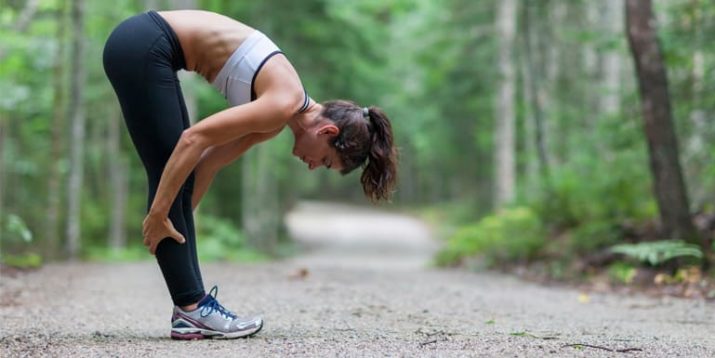
Do you struggle to touch your toes? Suffer lower-back pain? Have poor posture? These may all be signs that you need to learn how to loosen tight hamstrings.
Physiologically speaking, hamstring tightness involves the shortening of the muscle belly — the center or “meat” of the muscle — among the three muscles on the backs of your thighs, explains physical therapist Rob Ziegelbaum, D.P.T., clinical director at Zelik Ziegelbaum Physical Therapy.
A shortened muscle belly increases tension on the tendons, which leads to less flexibility in your hams, and decreased range of motion in the surrounding joints — the hip and the knee.
“Some people are born with limited elasticity in their muscles and are, therefore, naturally less flexible,” says Ziegelbaum.
Women, incidentally, tend to be more flexible in general than men, and young children are more flexible than most adults, he says.
Failing to stretch thoroughly and effectively pre- and post-workout can also contribute to tight hamstrings.
“During and after a workout, our muscles tighten up in part to protect our joints and in part because of the depletion of water since dehydration tightens muscles,” Ziegelbaum says.
Of course, working a desk job doesn’t help matters either.
“If you sit for eight hours a day and stretch your hamstrings for 20 minutes a day, you’re fighting an uphill battle,” says Keaton Ray, CSCS, PT, trainer, physical therapist and founder of MovementX in Portland, OR.
That’s why she recommends doing as much mobility work and stretching as possible throughout the day — including while you’re at work.
7 Tips to Loosen Tight Hamstrings
Everyone can train to improve their flexibility as part of a well-balanced fitness regimen, according to the American College of Sports Medicine.
1. Stretch Daily
Hamstring stretches should be part of a daily routine each morning, Ziegelbaum says. Here are some that you can do throughout the day.
Door frame stretch
- Lie on your back with your left buttocks against a wall at the edge of a corner or open door frame.
- Raise your left leg toward the ceiling and place your left heel against the wall. Extend your right leg on the floor inside the frame.
- Gently straighten your left leg. If you’re unable to fully straighten it, move your butt farther away from the wall to modify the stretch.
- Hold this position for 1 minute. Switch sides and repeat.
Modified hurdler
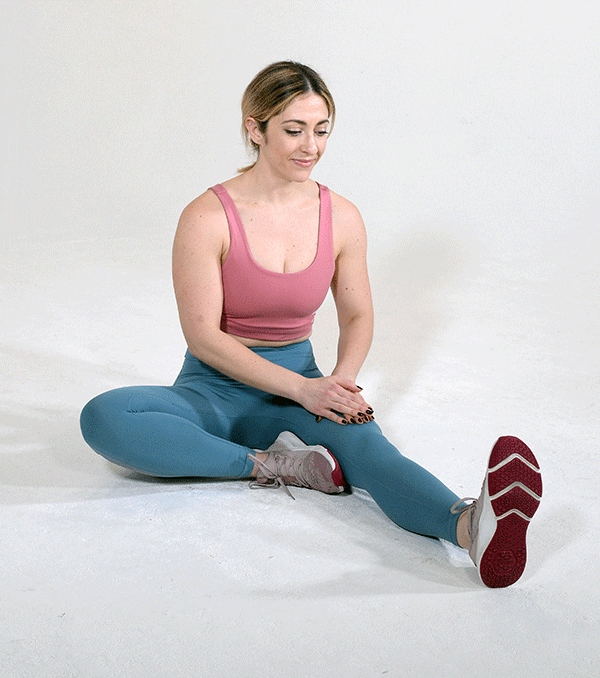
- Sit on the floor with your left leg extended and your right knee bent, placing the sole of your right foot against your inner left thigh. Your left toes should point toward the ceiling.
- Reach with both arms toward your left toes until you feel a stretch along the back of your left thigh. (It’s OK if you can’t touch your toes.)
- Hold for 30 seconds, then return to the starting position. Repeat for a total of 3 sets, then switch legs and repeat.
Figure four
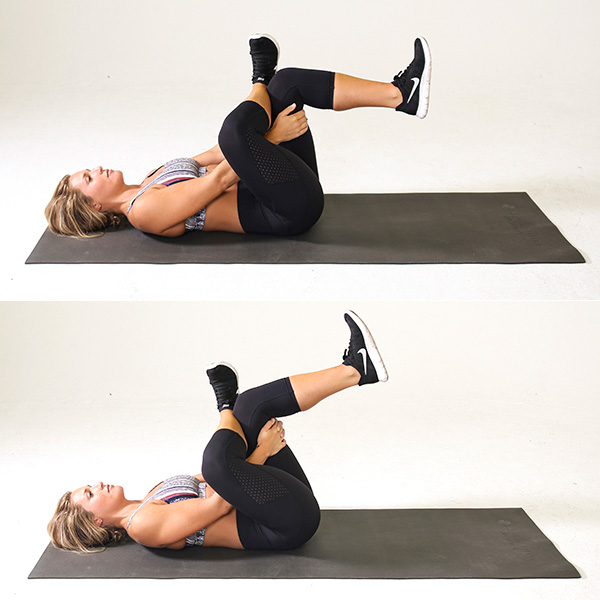
- Lie on your back with your knees bent and your feet flat on the floor.
- Place the outside of your left ankle against your right knee, and interlace your fingers behind your right thigh.
- Gently pull your right thigh toward your chest as far as you can without lifting your tailbone off the floor.
- When you feel a comfortable stretch, hold for 30 seconds. Then switch sides and repeat.
2. Stretch Before Activity
Before you run, lift, or sweat in any intentional way, move through a series of dynamic stretches — which work various ranges of motion — instead of static stretches, in which you hold one position for a length of time, Ray says.
These stretches will help prep your hamstrings for the work ahead.
Leg swings
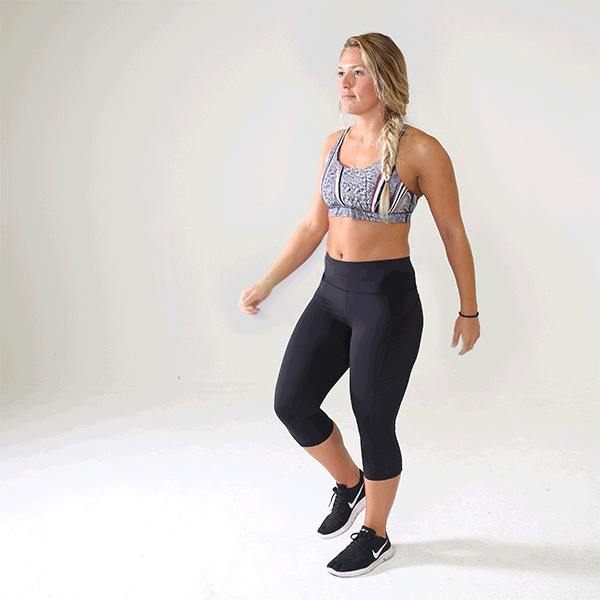
- Stand tall with your feet together and your arms at your sides or gripping a stable surface for balance.
- Shift your weight onto your right leg and swing your left leg forward and back.
- You should feel a stretch in your hamstrings when your leg is in front of your body and a hip flexor stretch when your leg swings backward.
- Perform 15 reps on each side.
Single-leg deadlift

- Stand with your feet hip-width apart with your arms at your sides.
- Shift your weight onto your right foot, lifting your left foot an inch or two off of the floor behind you.
- Keeping your right leg slightly bent, your back flat, and your core engaged, push your hips back into a hinge and lower your torso until it’s nearly parallel to the floor, raising your left leg behind you.
- Keeping your back leg and torso straight, hinge back to the starting position, performing a total of 10 reps on each side.
World’s greatest stretch
- Stand with your feet hip-width apart, and take a large step forward with your right foot.
- Place your hands on the floor on either side of your right foot.
- Let your hips sink toward the floor so that you feel a stretch in the front of your left hip, and hold for about 5 seconds.
- Keeping your hands on the floor, push your hips back so that your right leg begins to straighten. When you feel a stretch in your hamstrings, hold for 5 seconds. For an additional stretch, pull the toes of your front leg off the ground.
- Return to lunge position and switch sides, performing the stretch a total of 6 times on each leg.
3. Foam Roll After a Workout
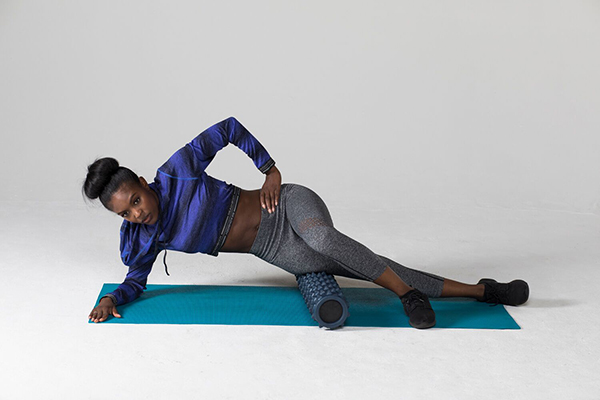
Using a foam roller after exercise stimulates blood flow to muscles, manually relieving tension and even reducing delayed-onset muscle soreness (DOMS).
- Sit on the floor with your legs extended in front of you and a foam roller under your thighs. Place your hands on the floor on either side of your hips.
- Lift your butt and use your hands to shift the entire length of your hamstrings — from just below your butt to your knees — back and forth over the roller for 30 seconds to a minute.
4. Perfect Your Posture
“When we sit with slouched postures our pelvis tilts backwards and causes a chronic shortening of the hamstring tendon over time,” Ray says. Here’s how to help fix it.
- Sit tall in a chair with your feet hip-width apart and parallel to one another.
- Bring your back away from the chair, maintaining the natural S-curve of your spine.
- Engage your core.
- Lock your shoulders back and down.
- Reach forward for your keyboard, and re-align your shoulders (this is often the first aspect of posture at a desk to go).
- Set an alarm every 30 minutes to re-align yourself.
5. Upgrade to a Standing Desk
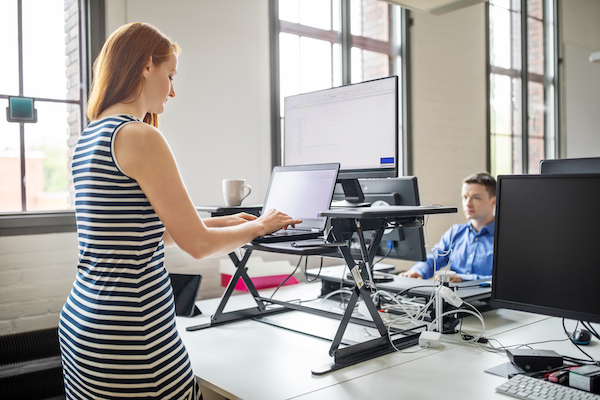
You can increase your flexibility by standing up and stretching more often. But even better is to upgrade to a standing desk if possible.
“Tight hamstrings are a result of adaptive (muscle) shortening. If someone sits at a desk for prolonged periods, knees bent, hamstrings contracted, the muscle effectively changes to the required length, which is shorter than that of a person who’s standing or stretching regularly,” Ziegelbaum explains.
Ray agrees. “[A standing desk] will help situate your pelvis in a way that holds your hamstrings in a naturally lengthened position.”
6. Stretch During Work

We all slouch — if you’re sitting all afternoon (or longer than 60 minutes, really), Ray advises performing this seated hamstring stretch for every 90 minutes you’ve been sitting uninterrupted.
- Sit tall at the edge of your desk chair, and extend your right leg straight in front of you with your toes pointed toward the ceiling.
- Without rounding your lower back, hinge at your hips and bring your chest toward your thigh until you feel a stretch in your hamstrings.
- Hold or perform small pulses in this position for 1 minute on each side.
7. Practice Yoga at Least Once a Week

Exploring more formal and lengthy mobility work like yoga or Pilates classes is always a good idea, Ziegelbaum says.
And studies from the National Institutes of Health found that active stretches (postures held through a full range of motion) may help increase hamstring length in just 6 to 8 weeks.
Why Runners Need to Pay Special Attention to Their Hams
Many athletes have tighter hamstrings — but runners have it especially bad.
“I often see long-distance runners who gradually lose flexibility in hamstrings and calves,” says exercise physiologist Janet Hamilton, C.S.C.S., owner of Running Strong Professional Coaching in Atlanta.
Researchers aren’t entirely sure why runners get so tight, but Hamilton’s guess is that it stems from weak gluteal muscles, since the glutes and hamstrings work in synergy to propel you forward.
“If one member of the team isn’t contributing as much as they should, then the other member of that team has to contribute more,” she adds. “This potentially leads to overuse and might be to blame for what we interpret as tightness.”
It’s especially important for runners to follow all of the above methods, as well as warming up with drills that mimic the activities of the ensuing workout — skips, hops, high-knees — but at lower intensity, she adds.
Don’t Forget to Mobilize the Rest of Your Body
The bigger problem with tight hams, all our experts agree, is actually the limited mobility of the surrounding muscles.
“Things in the human body are intricately related to one another,” Hamilton says. “Movement at one segment often depends on something happening at another segment. If your hamstrings are tight, that’s going to affect the biomechanics of the two connecting joints: the knee and the hip. Tight hamstrings are often associated with a whole host of injuries, including various low-back pain syndromes, knee injuries, and even plantar fasciitis.”
In fact, a study published in the journal Foot & Ankle Specialist, found that having tight hamstrings makes you nearly nine times as likely to suffer from plantar fasciitis. Yikes!
Plus, tight hammies can actually hurt your athletic performance. “Muscles that are ‘tight’ are often weak as well,” Hamilton says. “If a muscle is weak, you’ll have to recruit more motor units to accomplish a task, which may increase fatigue… and a fatigued muscle can’t produce force as well as one that is not,” she adds.
In particular, doing range-of-motion work on your hips, adductors, IT bands, and calves can all help loosen the surrounding muscles and keep your body fully functional.
